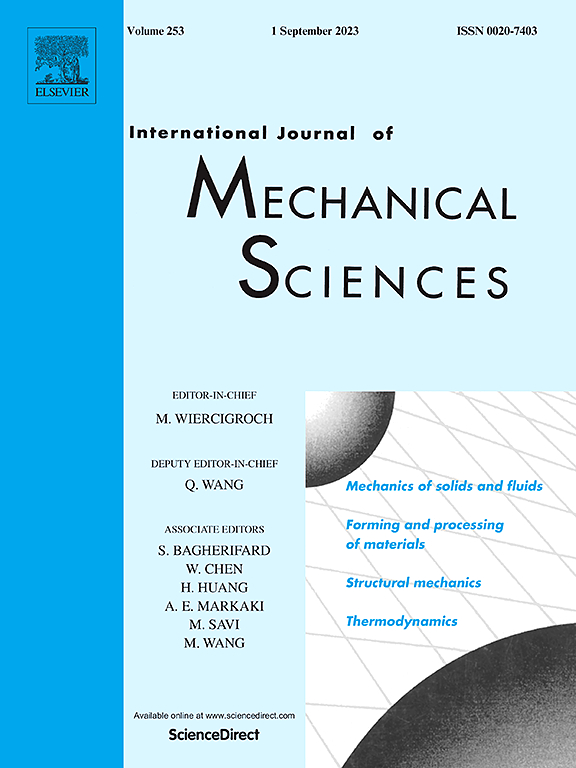三浦折纸启发的准零刚度低频隔振器
IF 7.1
1区 工程技术
Q1 ENGINEERING, MECHANICAL
International Journal of Mechanical Sciences
Pub Date : 2025-04-17
DOI:10.1016/j.ijmecsci.2025.110283
引用次数: 0
摘要
非线性隔振的最新进展揭示了传统线性隔振器的局限性,而现有的非线性隔振器在保持有效低频性能的同时往往缺乏对变化载荷的适应性。为了解决这些问题,本文通过集成折纸结构和线性弹簧组合,介绍了一种具有准零刚度(QZS)特性的新型连杆式三浦折纸(LMO)隔振器。所提出的系统展示了独特的参数优化能力,在保持非线性刚度特性的同时,使QZS性能在多种负载条件下保持一致。采用平均方法的分析研究表明,与等效线性隔离器相比,LMO系统具有更宽的隔离带宽和显着降低的共振峰,具有优越的隔振性能。通过扫描频率、谐波和随机激励下的综合动态测试,实验验证了在1.6 Hz以上的有效振动衰减,在1-25 Hz频段内谐振峰完全抑制,均方根降低90%。这些研究结果表明,LMO隔离器是实际低频隔振应用的有前途的解决方案,特别是在运行要求性能稳定性和负载适应性的机电系统中。本文章由计算机程序翻译,如有差异,请以英文原文为准。

Miura-origami inspired quasi-zero stiffness low-frequency vibration isolator
Recent advances in nonlinear vibration isolation have revealed limitations in conventional linear isolators, yet existing nonlinear designs often lack adaptability to varying loads while maintaining effective low-frequency performance. To address these challenges, this paper introduces a novel linkage-type Miura-origami (LMO) vibration isolator incorporating quasi-zero stiffness (QZS) characteristics through an integrated origami structure and linear spring combination. The proposed system demonstrates unique parameter optimization capabilities that enable consistent QZS properties across multiple load conditions while preserving nonlinear stiffness characteristics. Analytical investigations employing the averaging method reveal superior vibration isolation performance, with the LMO system exhibiting broader isolation bandwidth and significantly reduce resonance peaks compared to equivalent linear isolators. Experimental validation through comprehensive dynamic testing under sweep frequency, harmonic, and random excitations confirms effective vibration attenuation above 1.6 Hz, with complete resonance peak suppression and 90 % root mean square reduction in the 1–25 Hz frequency band. These findings establish the LMO isolator as a promising solution for practical low-frequency vibration isolation applications, particularly in electromechanical systems where operational demands require both performance stability and load adaptability.
求助全文
通过发布文献求助,成功后即可免费获取论文全文。
去求助
来源期刊

International Journal of Mechanical Sciences
工程技术-工程:机械
CiteScore
12.80
自引率
17.80%
发文量
769
审稿时长
19 days
期刊介绍:
The International Journal of Mechanical Sciences (IJMS) serves as a global platform for the publication and dissemination of original research that contributes to a deeper scientific understanding of the fundamental disciplines within mechanical, civil, and material engineering.
The primary focus of IJMS is to showcase innovative and ground-breaking work that utilizes analytical and computational modeling techniques, such as Finite Element Method (FEM), Boundary Element Method (BEM), and mesh-free methods, among others. These modeling methods are applied to diverse fields including rigid-body mechanics (e.g., dynamics, vibration, stability), structural mechanics, metal forming, advanced materials (e.g., metals, composites, cellular, smart) behavior and applications, impact mechanics, strain localization, and other nonlinear effects (e.g., large deflections, plasticity, fracture).
Additionally, IJMS covers the realms of fluid mechanics (both external and internal flows), tribology, thermodynamics, and materials processing. These subjects collectively form the core of the journal's content.
In summary, IJMS provides a prestigious platform for researchers to present their original contributions, shedding light on analytical and computational modeling methods in various areas of mechanical engineering, as well as exploring the behavior and application of advanced materials, fluid mechanics, thermodynamics, and materials processing.
 求助内容:
求助内容: 应助结果提醒方式:
应助结果提醒方式:


